
ProtegeOWLTutorial
.pdf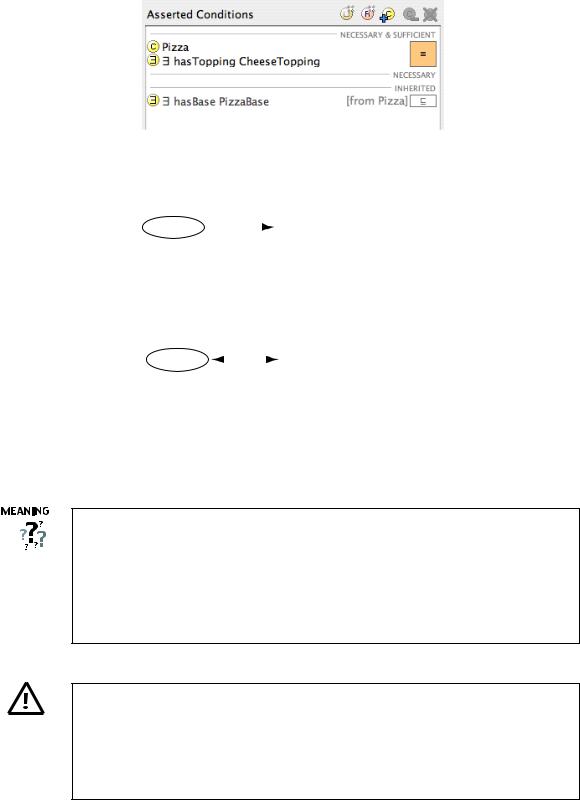
Figure 4.47: The Description of CheesyPizza (Using Necessary AND Su cient Conditions)
|
|
|
|
|
NECESSARY CONDITIONS |
|
|
|
|
|
|
|
|
|
|
|
Condition |
|
|
|
|
|
|
NamedClass |
implies |
|
Condition |
||
|
|
|
|
Condition |
|
|
|
|
|
|
|
|
|
|
|
|
|
|
|
|
|
|
Condition |
If an individual is a member of ‘NamedClass’ then it must satisfy the conditions. However if some individual satisfies these necessary conditions, we cannot say that it is a member of ‘Named Class’ (the conditions are not ‘sufficient’ to be able to say this) - this is indicated by the direction of the arrow.
|
|
|
NECESSARY & SUFFICIENT CONDITIONS |
|||
|
|
|
|
|
|
|
|
|
|
|
|
Condition |
|
|
|
|
|
|
|
|
NamedClass |
implies |
|
|
|
Condition |
|
|
|
|
|
Condition |
|
|
|
|
|
|
|
|
|
|
|
|
|
|
|
|
|
|
|
|
|
Condition |
|
|
|
|
|
|
|
|
If an individual is a memeber of ‘NamedClass’ then it must satisfy the conditions. If some individual satisfies the condtions then the individual must be a member of ‘NamedClass’ - this is indicated by the double arrow.
Figure 4.48: Necessary And Su cient Conditions
We have converted our description of CheesyPizza into a definition. If something is a CheesyPizza then it is necessary that it is a Pizza and it is also necessary that at least one topping that is a member of the class CheeseTopping. Moreover, if an individual is a member of the class Pizza and it has at least one topping that is a member of the class CheeseTopping then these conditions are su cient to determine that the individual must be a member of the class CheesyPizza. The notion of necessary and su cient conditions is illustrated in Figure 4.48.
If you accidentally dropped Pizza onto the “NECESSARY & SUFFICIENT” header (rather that onto the hasTopping CheeseTopping) in Exercise 29 the conditions widget will look like the picture shown in Figure 4.49. In this case, a new necessary and su cient condition has been created, which is not what we want. To correct this mistake, drag Pizza on top of the hasTopping CheeseTopping restriction.
60
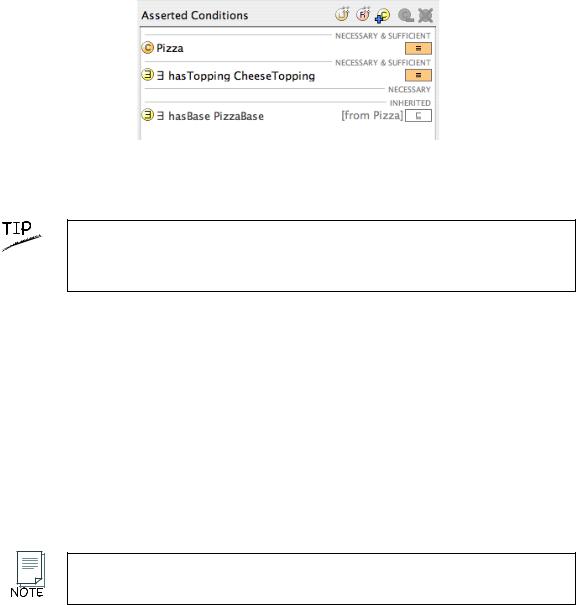
Figure 4.49: An INCORRECT description of CheesyPizza
Conditions may also be transferred from “NECESSARY” to “NECESSARY & SUFFICIENT” and vice versa using Cut and Paste. Right click (ctrl click on a Mac) on a condition and select Cut or Paste from the popup menu.
To summarise: If class A is described using necessary conditions, then we can say that if an individual is a member of class A it must satisfy the conditions. We cannot say that any (random) individual that satisfies these conditions must be a member of class A. However, if class A is now defined using necessary and su cient conditions, we can say that if an individual is a member of the class A it must satisfy the conditions and we can now say that if any (random) individual satisfies these conditions then it must be a member of class A. The conditions are not only necessary for membership of A but also su cient to determine that something satisfying these conditions is a member of A.
How is this useful in practice? Suppose we have another class B, and we know that any individuals that are members of class B also satisfy the conditions that define class A. We can determine that class B is subsumed by class A — in other words, B is a subclass of A. Checking for class subsumption is a key task of a description logic reasoner and we will use the reasoner to automatically compute a classification hierarchy in this way.
In OWL it is possible to have multiple sets of necessary & su cient conditions. This is discussed later in section 6.5
4.10.1Primitive And Defined Classes
Classes that have at least one set of necessary and su cient conditions are known as defined classes — they have a definition, and any individual that satisfies the definition will belong to the class. Classes that do not have any sets of necessary and su cient conditions (only have necessary conditions) are know as primitive classes. In Prot´eg´-OWL defined classes have a class icon with an orange background. Primitive classes have a class icon that has a yellow background. It is also important to understand that the reasoner can only automatically classify classes under defined classes - i.e. classes with at least one set of necessary and su cient conditions.
61

Figure 4.50: The Asserted and Inferred Hierarchies Displaying The Classification Results For CheesyPizza
4.11Automatic Classification
Being able to use a reasoner to automatically compute the class hierarchy is one of the major benefits of building an ontology using the OWL-DL sub-language. Indeed, when constructing very large ontologies (with upwards of several thousand classes in them) the use of a reasoner to compute subclass-superclass relationships between classes becomes almost vital. Without a reasoner it is very di cult to keep large ontologies in a maintainable and logically correct state. In cases where ontologies can have classes that have many superclasses (multiple inheritance) it is nearly always a good idea to construct the class hierarchy as a simple tree. Classes in the asserted hierarchy (manually constructed hierarchy) therefore have no more than one superclass. Computing and maintaining multiple inheritance is the job of the reasoner. This technique13 helps to keep the ontology in a maintainable and modular state. Not only does this promote the reuse of the ontology by other ontologies and applications, it also minimises human errors that are inherent in maintaining a multiple inheritance hierarchy.
Having created a definition of a CheesyPizza we can use the reasoner to automatically compute the subclasses of CheesyPizza.
Exercise 30: Use the reasoner to automatically compute the subclasses of CheesyPizza
1.Ensure that a reasoner (RACER) is running.
2.Press the ‘Classify Taxonomy...’ button on the toolbar (See Figure 4.42).
After a few seconds the inferred hierarchy should have been computed and the inferred hierarchy window will pop open (if it was previously closed). The inferred hierarchy should appear similar to the picture shown in Figure 4.50. Figures 4.51 and 4.52 show the OWLViz display of the asserted and inferred hierarchies respectively. Notice that classes which have had their superclasses changed by the reasoner are shown in blue.
13Sometimes know as ontology normalisation.
62
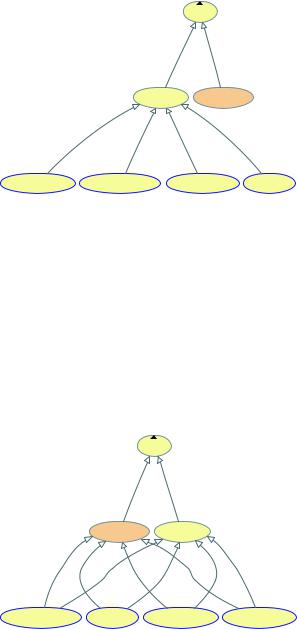
|
|
|
|
Pizza |
|
|
|
|
|
|
is-a |
is-a |
|
|
|
NamePizza |
CheesyPizza |
|||
|
is-a |
is-a |
|
is-a |
|
is-a |
MargheritaPizza |
AmericanHotPizza |
AmericanaPizza |
SohoPizza |
|||
Figure 4.51: OWLViz Displaying the Asserted Hierarchy for CheesyPizza
|
|
|
Pizza |
|
|
|
|
|
|
is-a |
is-a |
|
|
|
CheesyPizza |
|
NamePizza |
|
||
is-a |
is-a |
is-a |
is-a |
is-a |
is-a |
is-a is-a |
AmericanHotPizza |
SohoPizza |
MargheritaPizza |
AmericanaPizza |
|||
Figure 4.52: OWLViz Displaying the Inferred Hierarchy for CheesyPizza
63

The reasoner has determined that MargheritaPizza, AmericanaPizza, AmericanHotPizza and SohoPizza are subclasses of CheesyPizza. This is because we defined CheesyPizza using necessary and su cient conditions. Any individual that is a Pizza and has at least one topping that is a CheeseTopping is a member of the class CheesyPizza. Due to the fact that all of the individuals that are described by the classes MargheritaPizza, AmericanaPizza, AmericanHotPizza and SohoPizza are Pizzas and they have at least one topping that is a CheeseToppinga the reasoner has determined that these classes must be subclasses of
CheeseTopping.
aOr toppings that belong to the subclasses of CheeseTopping
It is important to realise that, in general, classes will never be placed as subclasses of primitive classes (i.e. classes that only have necessary conditions) by the reasonera.
aThe exception to this is when a property has a domain that is a primitive class. This can coerce classes to be reclassified under the primitive class that is the domain of the property — the use of property domains to cause such e ects is strongly discouraged.
4.11.1Classification Results
After the reasoner has been invoked, computed superclass-subclass relationships and inconsistent classes are displayed in the ‘Classification Results’ pane shown in Figure 4.53. The ‘Classification Results’ pane pops open after classification at the bottom of the Prot´eg´-OWL application window. The ‘spanner icon’ on the left hand side of the pane is the ‘Assert Selected Change(s)’ button. Pressing this button takes the superclass-subclass relationships that have been found by the reasoner and puts them into the asserted (manually constructed) hierarchy. For example, if the ‘Assert Selected Changes’ button was pressed with the selection shown in Figure 4.53, CheesyPizza would be added as a superclass of
AmericanaPizza.
Despite that fact that this facility exists, it is generally considered a bad idea to put computed/inferred relationships into the ‘manually constructed’ or asserted model whilst an ontology is being developed — we therefore advise against using this button during the development of an ontology.
4.12Universal Restrictions
All of the restrictions we have created so far have been existential restrictions ( ). Existential restrictions specify the existence of at least one relationship along a given property to an individual that is a member of a specific class (specified by the filler). However, existential restrictions do not mandate that the only relationships for the given property that can exist must be to individuals that are members of the specified filler class.
64
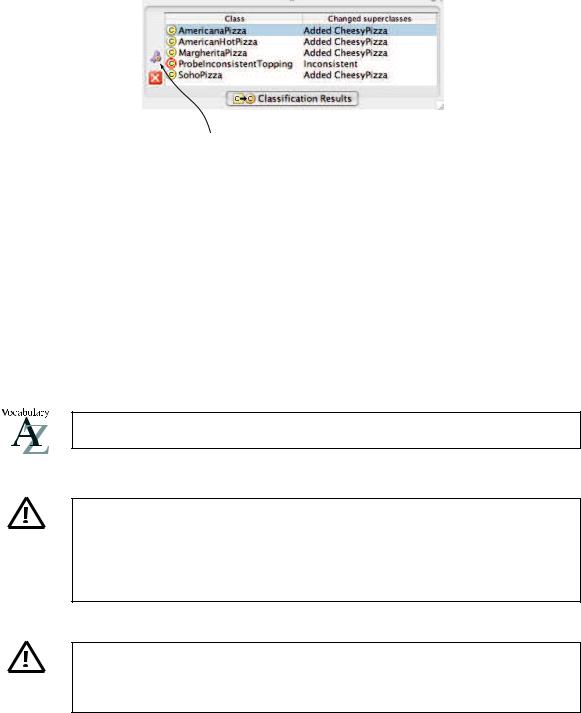
Assert selected change(s)
Figure 4.53: The Classification Results Pane
For example, we could use an existential restriction hasTopping MozzarellaTopping to describe the individuals that have at least one relationship along the property hasTopping to an individual that is a member of the class MozzarellaTopping. This restriction does not imply that all of the hasTopping relationships must be to a member of the class MozzarellaTopping. To restrict the relationships for a given property to individuals that are members of a specific class we must use a universal restriction.
Universal restrictions are given the symbol . They constrain the relationships along a given property to individuals that are members of a specific class. For example the universal restriction hasTopping MozzarellaTopping describes the individuals all of whose hasTopping relationships are to members of the class MozzarellaTopping — the individuals do not have a hasTopping relationships to individuals that aren’t members of the class MozzarellaTopping.
Universal restrictions are also know as All Restrictions.
The above universal restriction hasTopping MozzarellaTopping also describes the individuals that do not participate in any hasTopping relationships. An individual that does not participate in any hasTopping relationships what so ever, by definition does not have any hasTopping relationships to individuals that aren’t members of the class MozzarellaTopping and the restriction is therefore satisfied.
For a given property, universal restrictions do not specify the existence of a relationship. They merely state that if a relationship exists for the property then it must be to individuals that are members of a specific class.
Suppose we want to create a class called VegetarianPizza. Individuals that are members of this class can only have toppings that are CheeseTopping or VegetableTopping. To do this we can use a universal
65

restriction.
Exercise 31: Create a class to describe a VegetarianPizza
1.Create a subclass of Pizza, and name it VegetarianPizza.
2.Making sure that VegetarianPizza is selected, click on the ”NECESSRY” header in the ‘Conditions Widget’.
3.Press the ‘Create restriction’ button on the ‘Conditions Widget’ to display the ‘Create restriction dialog’.
4.Select the type of restriction as ‘ allValuesFrom’ in order to create a universally quantified restriction.
5.Select hasTopping as the property to be restricted.
6.For the filler we want to say CheeseTopping or VegetableTopping. First insert the class CheeseTopping either by typing CheeseTopping into the filler box, or by using the ‘Insert class’ button. We now need to use the unionOf operator between the class names. The unionOf operator may be inserted using the button shown in Figure 4.54a. Insert the unionOf symbol by pressing the ‘Insert unionOf ’ button on the expression builder panel. Next insert the class VegetableTopping either by typing it or by using the ‘Insert class button’. You should now have CheeseTopping t VegetableTopping in the filler edit box.
7.Press the ‘OK’ button on the dialog to close the dialog and create the restriction — if there are any errors (due to typing errors etc.) the dialog will not close and an error message will be displayed at the bottom of the expression builder panel.
aSee section B.2 for more information about union classes.
At this point the conditions widget should look like the picture shown in Figure 4.55.
66
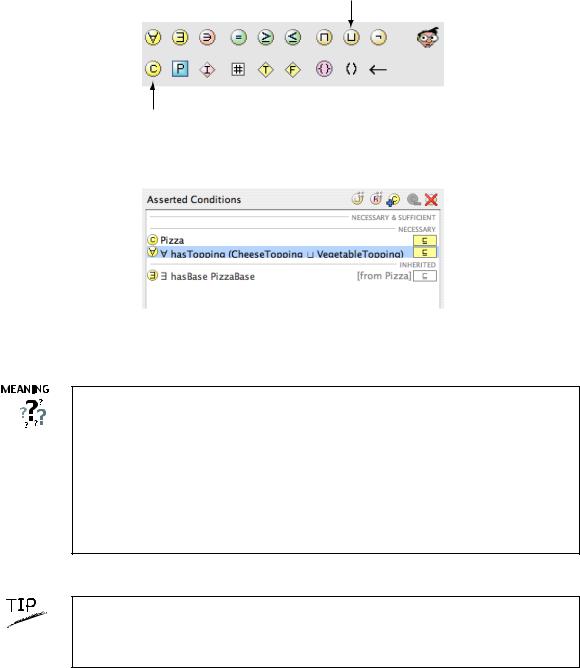
Insert union of
Insert class
Figure 4.54: Using the Expression Builder Panel to insert Union Of
Figure 4.55: The Description of VegetarianPizza (Using Necessary Conditions)
This means that if something is a member of the class VegetarianPizza it is necessary for it to be a kind of Pizza and it is necessary for it to only ( universal quantifier) have toppings that are kinds of CheeseTopping or kinds of VegetableTopping.
In other words, all hasTopping relationships that individuals which are members of the class VegetarianPizza participate in must be to individuals that are either members of the class CheeseTopping or VegetableTopping.
The class VegetarianPizza also contains individuals that are Pizzas and do not participate in any hasTopping relationships.
Instead of using the ‘Insert unionOf ’ button in Exercise 31 , we could have simply typed or into the filler edit box and it would have automatically been converted to the union of symbol (t).
67
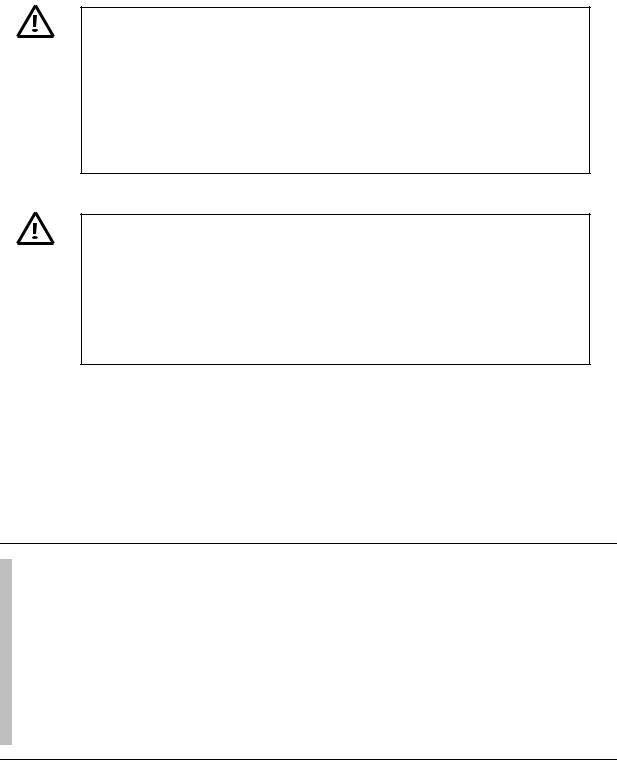
In situations like the above example, a common mistake is to use an intersection instead of a union. For example, CheeseTopping u VegetableTopping. This reads, CheeseTopping and VegetableTopping. Although “CheeseTopping and Vegetable” might be a natural thing to say in English, this logically means something that is simultaneously a kind of CheeseTopping and VegetableTopping. This is obviously incorrect as demonstrated in section 4.9.4. If the classes CheeseTopping and VegetableTopping were not disjoint, this would have been a logically legitimate thing to say – it would not be inconsistent and therefore would not be ‘spotted’ by the reasoner.
In the above example it might have been tempting to create two universal restrictions — one for CheeseTopping ( hasTopping CheeseTopping) and one for VegetableTopping ( hasTopping VegetableTopping). However, when multiple restrictions are used (for any type of restriction) the total description is taken to be the intersection of the individual restrictions. This would have therefore been equivalent to one restriction with a filler that is the intersection of MozzarellaTopping and TomatoTopping — as explained above this would have been logically incorrect.
Currently VegetarianPizza is described using necessary conditions. However, our description of a VegetarianPizza could be considered to be complete. We know that any individual that satisfies these conditions must be a VegetarianPizza. We can therefore convert the necessary conditions for VegetarianPizza into necessary and su cient conditions. This will also enable us to use the reasoner to determine the subclasses of VegetarianPizza.
Exercise 32: Convert the necessary conditions for VegetarianPizza into necessary & sufficient conditions
1.Ensure that VegetarianPizza is selected in the class hierarchy.
2.On the ‘Conditions Widget’ select the ( universal) restriction on the hasTopping property.
3.Drag the hasTopping restriction from under the “NECESSARY” header to on top of the “NECESSARY & SUFFICIENT” header.
4.Select the class Pizza.
5.Drag the class Pizza from under the “NECESSARY” header to on top of the hasTopping restriction (note not on top of the “NECESSARY & SUFFICIENT” header this time).
The ‘Conditions Widget’ should now look like the picture shown in Figure 4.56.
68
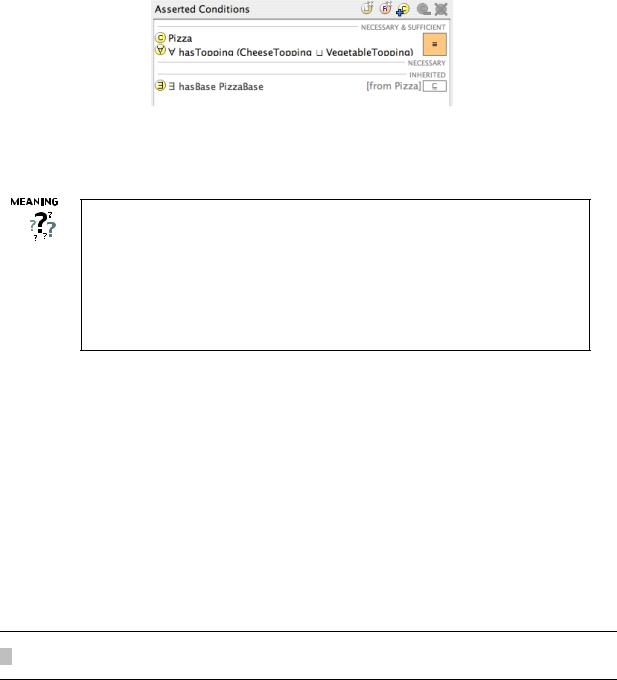
Figure 4.56: The Conditions Widget Displaying the Definition of VegetarianPizza (Using Necessary and Su - cient Conditions)
We have converted our description of VegetarianPizza into a definition. If something is a VegetarianPizza, then it is necessary that it is a Pizza and it is also necessary that all toppings belong to the class CheeseTopping or VegetableTopping. Moreover, if something is a member of the class Pizza and all of it’s toppings are members of the class CheeseTopping or the class VegetableTopping then these conditions are su cient to recognise that it must be a member of the class VegetarianPizza. The notion of necessary and su cient conditions is illustrated in Figure 4.48.
4.13Automatic Classification and Open World Reasoning
We want to use the reasoner to automatically compute the superclass-subclass relationship (subsumption relationship) between MargheritaPizza and VegetarianPizza and also, SohoPizza and VegetarianPizza. Recall that we believe that MargheritaPizza and SohoPizza should be vegetarian pizzas (they should be subclasses of VegetarianPizza). This is because they have toppings that are essentially vegetarian toppings — by our definition, vegetarian toppings are members of the classes CheeseTopping or VegetableTopping and their subclasses. Having previously created a definition for VegetarianPizza (using a set of necessary and su cient conditions) we can use the reasoner to perform automatic classification and determine the vegetarian pizzas in our ontology.
Exercise 33: Use the reasoner to classify the ontology
1. Ensure that a resoner (RACER) is running. Press the ‘Classify taxonomy’ button.
You will notice that MargheritaPizza and also SohoPizza have not been classified as subclasses of VegetarianPizza. This may seem a little strange, as it appears that both MargheritaPizza and SohoPizza have ingredients that are vegetarian ingredients, i.e. ingredients that are kinds of CheeseTopping or kinds of VegetableTopping. However, as we will see, MargheritaPizza and SohoPizza have something missing from their definition that means they cannot be classified as subclasses of VegetarianPizza.
Reasoning in OWL (Description Logics) is based on what is known as the open world assumption (OWA). It is frequently referred to as open world reasoning (OWR). The open world assumption means that we
69
